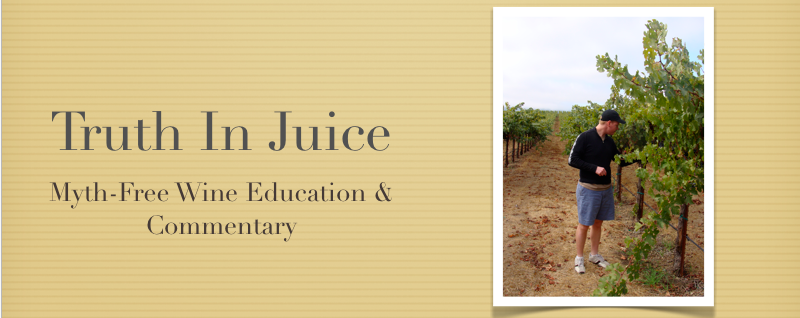A reader named Chris recently wrote in looking for guidance about whether to drink or age the wines in his collection. I imagined many readers might have similar questions or concerns from time to time, so here's Chris' question, along with my response:
I have about 25 mixed cases of wine, mostly cabs and red blends, mostly Californian, ranging from the late 1980s right up to the 2010 vintage. Ridge, Beringer, Cakebread, Heitz, Caymus, Dunn, Baldacci, Black Sears, Pahlmayer, Grgich, Bell, Mount Veeder, Hess Collection, Von Strasser, Gargiulo, Larkmead, Vine Cliff, Laird, PIna, etc. Are there people out there who are prepared to give free advice about what to drink up and what to sit on for a while longer? Can you point me in the right direction?
Hi Chris,
Thanks for the question. That's an impressive collection, and you've demonstrated some incredible patience by sitting on the wines from the late 1980s for this long.
The question of when to drink wines is a simple one in some respects, and more complicated in others. At the most basic level, I tell people to drink their wines when the impulse strikes them. Too often, people hang on to wines for so long that they become too special to open, and when they finally are, they've passed their prime. Former
Wall Street Journal wine columnists, Dorothy J. Gaiter and John Brecher, started a tradition called
Open That Bottle Night (OBTN), to encourage people to "drink the wines that they would never open otherwise."
I don't want to suggest that all your wines have passed their prime, but I'd definitely encourage you to start drinking a few of the wines, especially the ones from the late 1980s. After all, we buy wine with the intention of drinking it, right? While Cabernet Sauvignon has incredible potential to age, especially when made by some of the superstar producers you mentioned, you certainly wouldn't be committing infanticide by opening up a few of those bottles right now. The younger bottles, you can probably safely lay down for a few years.
The more complex side of deciding when to drink wines involves both characteristics of the wine, and personal preference. Do you prefer your wines young, with aggressive tannins, and more straight forward fruit flavors? Are you someone who appreciates an aged, mature wine, with softer tannins and secondary aromas and flavors, such as muted red fruits, tobacco, forest floor, spice box, cedar, and leather? Determining your own preference with respect to the age of your wine is an important first step. In my
Wine Discovery Classes, I always make sure to feature a mini-vertical tasting in one of the classes, where we taste the same wine from two different vintages, to show the effects of bottle age. It's always one of my favorite parts of the class, as it is something most wine drinkers don't get to do on a regular basis. You're very fortunate, as it sounds like your collection offers you the chance to conduct vertical tastings more often than most.
Aside from your own taste preferences, some factors to consider when deciding when to drink or age your wines are the vintage of the wine, the pedigree of the wine, and your personal storage conditions. While it's tough to make generalizations about which wines will age well, wine's ability to age is ultimately influenced by it's tannic structure. Tannins are bitter plant polyphenols, which are also found in tea leaves, and some other fruits. You may have noticed the effects of tannins if you have ever over-steeped a cup of tea, and noticed a mouth puckering, drying sensation when you took a sip. In wine, tannins are what prevent the wine from oxidizing, and are found in the skins, stems, and seeds of the grapes. Tannins also exist in wood, and can be imparted to wine when it is aged in oak barrels. They break down as the wine ages, which is why older wines have a softer tannic structure. This also means that wines with more tannin have the ability to age longer than wines with fewer tannins. Plush, fruit forward reds that are designed to be more approachable in their youth are generally not conducive to aging, while wines that may be somewhat austere when young (due to tannins) can be excellent wines to lay down for a while.
Of course, tannin is not the only factor that influences a wine's ability to age. The other components of a wine's ability to age are its levels of acidity, and the ripeness of the grapes. Acidity plays a role in keeping the wine fresh, while the ripeness of the grapes is responsible for the fruit flavors of the wine. If wine didn't taste like fruit to some extent, I think it's safe to say it would be a far less popular beverage. As grapes from the best vintages tend to be more ripe, and have more balanced acidity, wines made from those grapes will generally demonstrate a better potential to age. This also extends to the vineyards. The best grapes in each vintage will generally produce wines that are more capable of aging than that wines made from grapes that were neglected in the vineyard. To that end, if you're looking to age wines, I'd try to select wines from highly rated vintages, and well regarded vineyard sites and vineyard managers.
When looking at the types of wines that are designed to be aged, they are wines that have sourced the best grapes available, and have appropriate levels of tannin, acidity and fruit. Generally, they have also seen an extended period of oak aging. Because the process of sourcing the best grapes, and aging the wine in oak barrels results in added winemaking costs, it generally means that the wines designed to be aged are typically some of the more expensive wines available to consumers. To that end, you won't have too many problems with most of the wines in your collection, but I'd be careful about trying to age inexpensive wines for more than a couple years.
The last caveat that I'd make, is that the storage conditions also influence wine's ability to age. The ideal storage conditions for wine call for a temperature of 55 degrees Fahrenheit, minimal light, and no vibration. Most of us aren't lucky to enjoy perfect cellaring conditions, but if you've been storing your wines in conditions other than those mentioned above, you can expect that they will have aged more quickly than they would have if they had been stored perfectly.
In closing, I'd remind you that we drink wine to enjoy it, and sometimes it is best to simply drink a bottle of the wine to determine how well it is aging. One of the advantages of buying multiple bottles of the same wine is that you can observe the wine's evolution over several years. If you're reluctant to open a specific wine, and are looking for guidance about when it will be good to drink, websites like
www.erobertparker.com have comprehensive databases of wines, and provide good estimates about when wines will reach maturity. However, rather than stress about opening the wine at the perfect moment, I'd encourage you to enjoy the contents of your impressive collection, and look for new wines to replace the wines you decide to drink.
Cheers!
 Thursday, October 18, 2012 at 5:30PM
Thursday, October 18, 2012 at 5:30PM 


Reader Comments